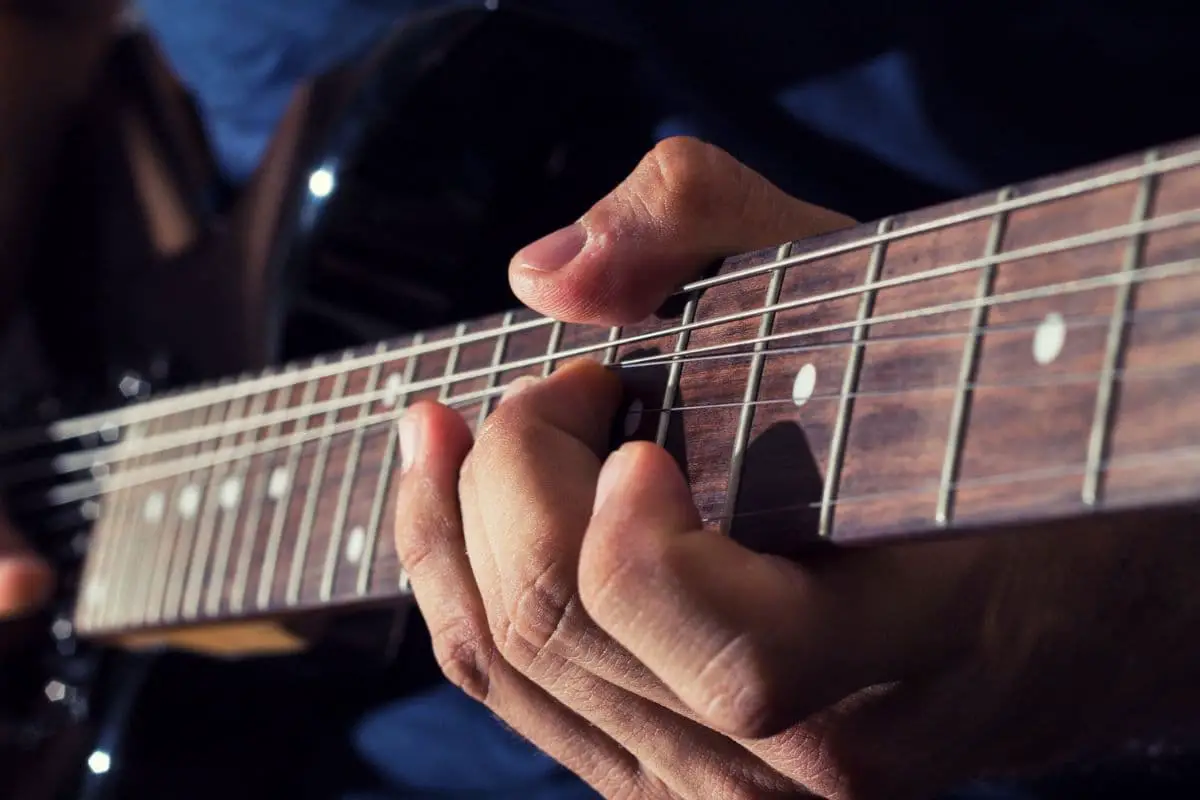Bending guitar strings is one of the most important and coolest guitar techniques you can learn. It’s essential in the blues, rock’n’roll, metal, and guitar solos are almost unimaginable without it. Its importance and omnipresence make it a key technique to learn, but it can sometimes be hard for a beginner to grasp because bending can get somewhat painful if you’re not used to it.
Bend guitar strings without hurting your fingers by setting up your guitar properly. Fresh strings and comfortable action and frets will help along with good technique. Use more than one finger and bend from your wrist and have patience and let calluses develop.
If you’ve just started learning this amazing guitar technique but aren’t sure if you can continue because of the pain, look no further. I’ll go over how to set up your guitar and adapt your technique to minimize or eliminate pain so you can play some amazing solos in no time.
3 Steps On How To Bend Guitar Strings Without Hurting Your Fingers
- Make Sure Your Guitar Is in Good Shape and Properly Set Up For Bending Strings: Check Your strings, make sure the action isn’t too high, inspect the fret height, and try down-tuning the guitar.
- Correct Your Technique When Bending Guitar Strings: Don’t rely on one finger and use your wrist.
- Let Calluses Develop To Easily Bend Guitar Strings: Learn on acoustic guitar, keep the nails on the fretting hand short, wipe your fingertips with rubbing alcohol, use an old credit card, and use thicker strings.
If you want to find out what my recommended guitar gear is, then here is what I recommend on Amazon:
- Fender Cutaway Acoustic-Electric Guitar Bundle (MY FAVORITE GUITAR)
- Snark SN-8 Super Tight All Instrument Tuner (Easiest Tuner I’ve Used)
- 6 String Acoustic Guitar Capo (Best CAPO for quick changes)
- Dunlop Max Grip 1.0mm Nylon Picks (Thick Guitar Pick So You Don’t Lose Grip!)
- Universal Guitar Stand (Cheap & Minimalist Guitar Stand I Recommend)
- Levy’s 2″ Wide Quick Adjust Guitar Strap (Best Guitar Strap For Any Level)
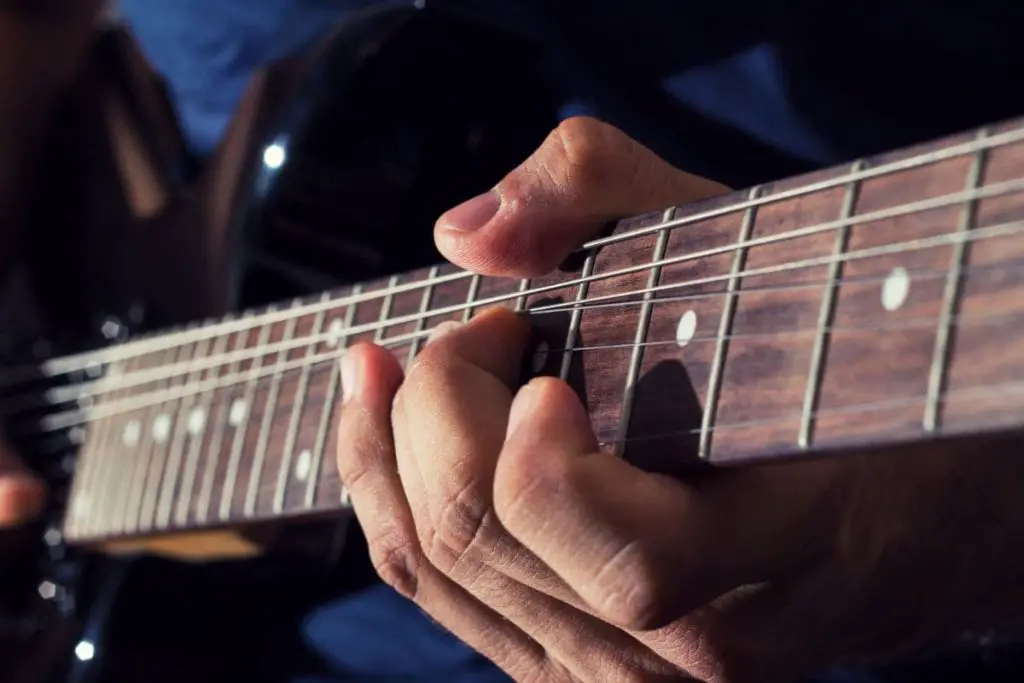
1. Make Sure Your Guitar Is in Good Shape and Properly Set Up To Easily Bend the Strings Without Hurt
If your guitar is in horrible condition, everything you play will feel uncomfortable and painful. Old rusty strings and frets that have been eaten away by time and overuse, coupled with improperly adjusted bridge and nut will turn your guitar playing into torture.
Let’s look at some key factors that will make bending much easier when you take care of them.
Check Your Strings
Of course, your guitar isn’t necessarily in such bad condition if you have trouble bending strings. However, one element in bad shape is enough to ruin the pleasure of playing. Quite often, it’s the strings.
No matter your style of playing, having a fresh set of strings on your guitar will help. Whenever something feels weird or off, check your strings. Over time, oil, sweat, and tiny pieces of skin from your fingers will accumulate in the windings, degrading them.
They might even rust if you are reckless with your guitar strings. Rusty strings aren’t just bad for your sound; they can be potentially bad for your health if you cut yourself accidentally. Therefore, clean your strings regularly and change when you hear a noticeable drop in sound quality.
It also helps to choose thinner strings. It makes sense that the thinner they are, the more bendable they are. However, if you get too thin strings, they may break relatively easily, so don’t go overboard with that.
Make Sure the Action Isn’t Too High
The guitar’s action is also an important factor. Action refers to how close to the frets or how far away from them the strings are. If the strings are close to the frets, we call that low action, and if they’re far away, it’s high action.
High action makes all types of fretting more difficult. The further away from the frets a string is, the more strength it takes to press and hold it. It’s even more difficult if you’re supposed to bend with high action.
Therefore, you want your guitar to have low action to make bending easier. Of course, you should not go too low. Otherwise, you’ll get a different host of problems, but lowering them will definitely alleviate some of them.
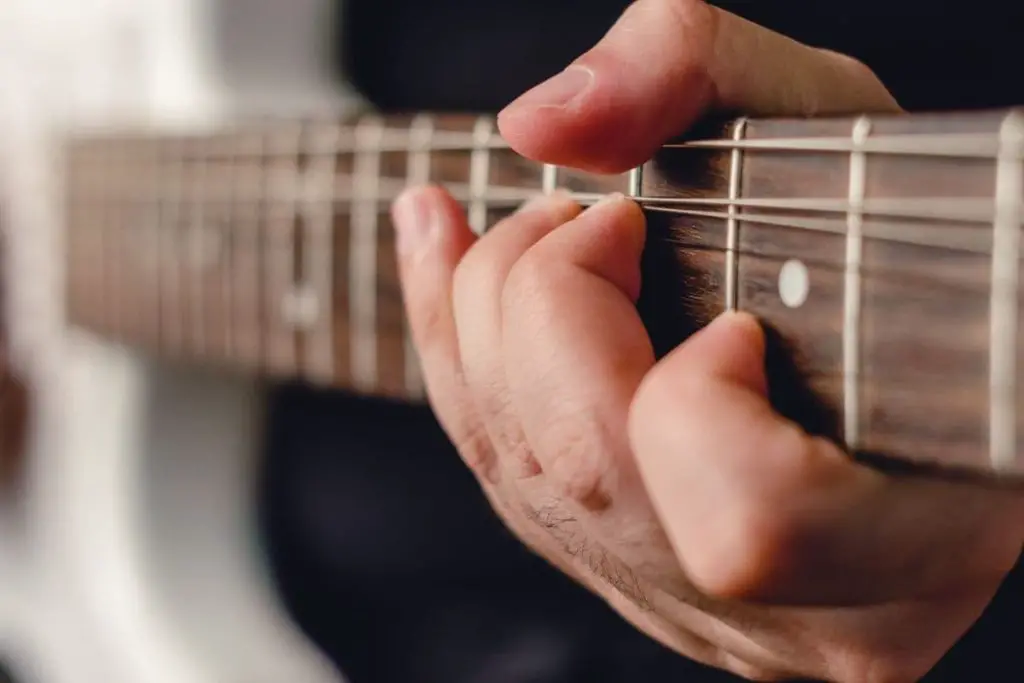
There are a few ways to lower the action.
- Use the truss rod.
- Sand the nut
- Sand the bridge saddle
Using the truss rod is the best option because it doesn’t permanently change your guitar. It’s a rod that creates a slight backward or forward bow in your guitar’s neck, thus changing the action. You need an Allen wrench to use it, and you just have to turn it clockwise a bit if you want lower action.
Sanding can be useful, but it’s not reversible, so it might be a problem if you want to sell the guitar later and the buyer wants higher action than they can get with a sanded nut and saddle. However, if you’re not planning to sell your guitar, you can feel free to sand off a bit of your nut and saddle and lower the action permanently.
Inspect the Fret Height
Fret height is another important factor regarding the ease of playing the guitar. Higher frets will mean that your fingertips won’t drag across the fretboard, so bends, hammer-ons, and other things will be much easier.
With higher frets, the strings have to move less, so less strength is necessary for fretting. Therefore, your hands and fingers will strain less, leading to less pain. However, high frets can be a double-edged sword.
If you have higher frets and press hard on the strings, they will dig into your fingers more, which might cause pain and discomfort. Therefore, you must be careful with high frets and refrain from pressing hard. However, you probably don’t have that problem if you’re a beginner.
Replacing your frets with a set of higher ones is a good idea for making your guitar playing more comfortable. It’s also a good idea if you’re particularly aiming to make bending easier. You can replace them yourself, but since it’s a relatively complicated procedure, it’s best to get a luthier to do it.
You’ll probably have to invest a few hundred dollars, but the benefits will be worth it. Of course, if you know what you’re doing, you can replace them yourself, but that takes a few years of experience to master, so you’re not likely to get it right at the first attempt, and there’s no point in risking damage to your guitar.
You Can Try Downtuning Your Guitar Slightly
A downtuned guitar will be easier to bend. This happens because the strings are looser, so you don’t have to use as much strength to bend them. Now, this doesn’t mean you have to go down to some weird djent tuning. Down-tuning by just half a step might make the strings loose enough to make bending easy. Of course, you’ll have to change the key if you’re playing a cover, but that won’t make matters too complicated most of the time.
2. Correct Your Technique of Bending Guitar Strings
When your guitar is properly set up for bending, you should start working on your technique. Even though bending seems like a super-straightforward technique, there’s more stuff to it than it might seem. This mostly has to do with what you do with your fingers and wrist.
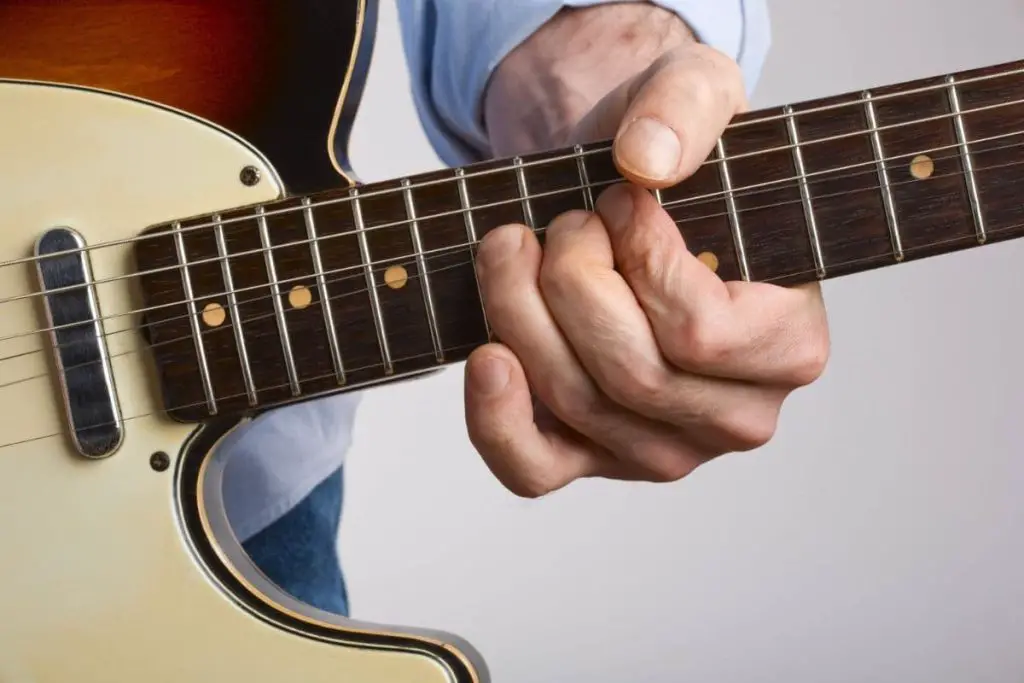
Let’s examine some key pointers that will help you bend with less strain on your fingers and, thus, less pain.
Don’t Rely on Only One Finger
You’ll always lead the bend with only one finger, usually the ring finger. However, that doesn’t mean that the entire bend has to be performed with only one finger. Ideally, you should use your middle and index fingers to help you.
Using three fingers instead of only one will help spread the pressure over a wider surface, which means you’ll hurt your index finger less. It will also make the bend easier because you’ll create more force with less effort.
Some guitarists feel that using three fingers is awkward. If you find that you fall in that camp, you can use two fingers instead. Even that might feel unusual initially, but you’ll see that it gradually becomes easier. Using only your index finger definitely isn’t a good idea long-term.
You might wonder how you’ll prevent your index and middle fingers from touching other strings and muffling your sound. The key is in slow and patient progress and touching the strings with the very tips of the fingers.
You probably won’t get the bend perfectly with three fingers immediately. Like any other technique, you must start slowly and work your way up. Take your time to position your fingers properly to understand how it’s supposed to feel, and repeat until you’re confident in your positioning. Start increasing the speed from there.
It’s also important to make contact with the strings using only the very tips of your fingers. You should touch the strings a few millimeters in front of the fingernails. This will allow you maximum precision, thus reducing the chances of you bending the wrong strings.
Use Your Wrist
One very common mistake that beginners make when bending strings is bending only with the fingers. This puts a lot of pressure on them and causes pain. While you might get away with this sometimes, most of the time, you’ll need to use your wrist as well. Sometimes, you might even need to throw in the elbow.
So, when you bend strings, rotate your wrist up as far as it can comfortably go. This will feel awkward initially, but when you get used to the movement, it will help significantly. You’ll produce more force if you move from a bigger joint, which will relieve your fingers and make them hurt less.
If there’s a particularly difficult bend you want to pull off, try pushing your elbow forward a little bit. This will extend your range of motion by an inch, allowing you to bend more easily. Of course, this is not to say that you should always bend from your elbow, but it can help in some cases.
3. Let Calluses Develop to More Easily Bend Guitar Strings Without Hurting Your Fingers
Unfortunately, having nice soft fingers doesn’t go hand in hand with playing guitar. Avoiding pain in your fingers means that the skin on your fingertips will have to harden. As you play, it will inevitably get damaged and form calluses as your body repairs it.
While this might throw you off, this process is perfectly normal, natural, and you shouldn’t fight it. In fact, you want your fingertips to get callused and hardened as soon as possible because hardened fingertips don’t hurt when fretting and bending.
This will happen over time as you play. Of course, when you first start playing, it will hurt a little, but that’s a part of the process. If you see that your fingertips are getting seriously hurt, take a break, but don’t give up if they are getting rough or the skin feels a bit sensitive. Soon, the skin on your fingertips will be like armor.
Let’s examine some additional tips for hardening your fingertips. This will help you significantly as you make progress with your guitar playing.
Learn on an Acoustic Guitar
Learning the basics of guitar on an acoustic one will make it easier to learn electric guitar. This is particularly true regarding the strength and toughness you need for this instrument.
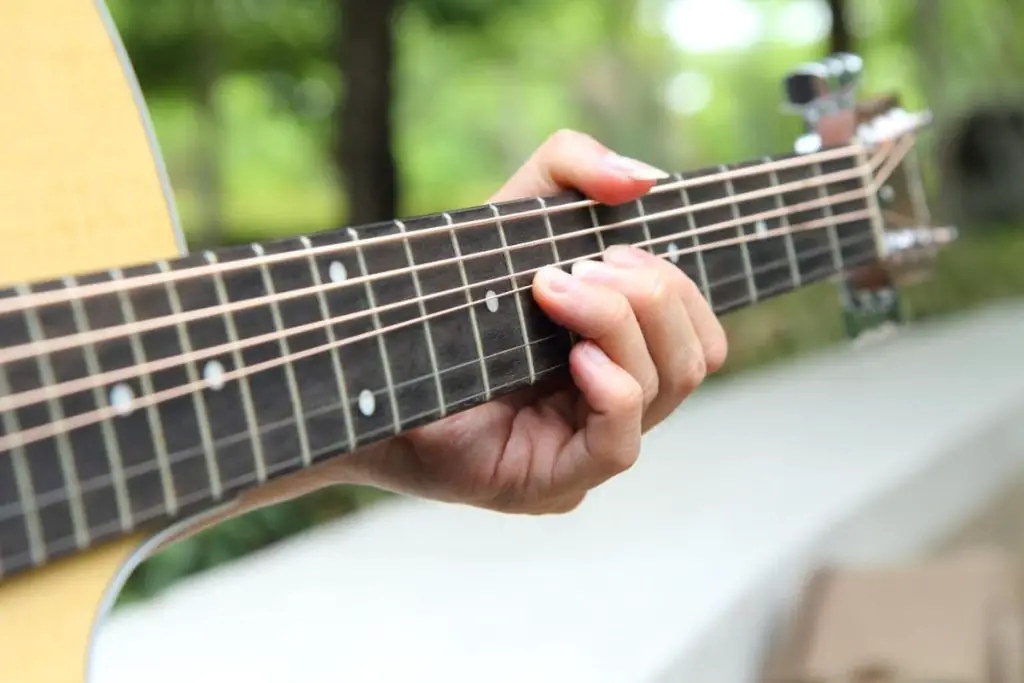
Acoustic guitars typically have steel strings which are also thicker, and they also have higher action. This will harden your fingertips much faster while also developing the strength in your fretting hand. Yes, starting with an acoustic guitar might be more difficult, but it’s a good long-term investment.
Keep the Nails on the Fretting Hand Short
While it’s perfectly acceptable to have the nails on your picking hand long if you play fingerstyle, long nails on your fretting hand are unacceptable. Not only does this ruin the sound of your guitar, but it also makes it more difficult for calluses to develop. This will make it much harder to harden your fingers.
Wipe Your Fingertips with Rubbing Alcohol
This piece of advice allegedly comes from Eric Clapton. The thinking behind this is that rubbing alcohol dries out your skin, which makes calluses develop faster. You can soak a cotton pad with alcohol and rub your fingers with it. It’s advisable to do this twice a week as a beginner (or someone who hasn’t played in a while) or three times as a more seasoned player.
You can use salt water if you’re not a fan of alcohol’s stench. There has to be a lot of salt in the water for this work. The idea is that salt draws moisture away from the skin, which again helps form calluses.
Use an Old Credit Card
Some hardcore, dedicated guitarists keep an old credit card (anything similar will work) in their pocket and press their fingertips into its edge to harden their skin. The goal is to simulate the pressure of a guitar string against the fingertips.
Alternatively, you can press your thumb’s nail into the tips of the other fingers, where they usually touch the strings. However, this can’t be a particularly nice feeling, so it might be best to opt for something else.
Get Thicker Strings
Lighter strings are easier to play and easier on your fingers, which doesn’t let them callus easily. Thicker strings will be much harder on your fingertips, so they’ll get callused more quickly. Yes, this will hurt more initially, but you’ll get hardened much sooner.
Avoid Skin Softeners and Conditioners
Softening your skin is the exact opposite of what you’re trying to do here. Therefore, avoiding any skin-softening products is crucial.
Lots of soaps and detergents also have softeners in them. Of course, you shouldn’t stop washing your hands, but you can use a sanitizer instead of soap or look for a soap with no softener in it. When doing the dishes, put on gloves to prevent the detergent from coming into contact with your skin.
Avoid Pressing Too Hard
Holding chords with all your might can look like a good way to strengthen your hand and harden your skin. However, it’s counterproductive. You should only press the strings as much as it’s necessary to get a decent sound.
Pressing too hard will make you develop a very tense style of playing, and you might develop tendonitis. Tendonitis might keep you away from your guitar for a few weeks, which will set you back significantly.
Practice Regularly
This is the easiest and most straightforward way to harden your hands. If you practice regularly, calluses will develop whether you aim for it or not, so learning how to bend properly will be much easier. Even if you just practice and do nothing else to speed the creation of calluses, your hands will probably be tough enough in a few months.
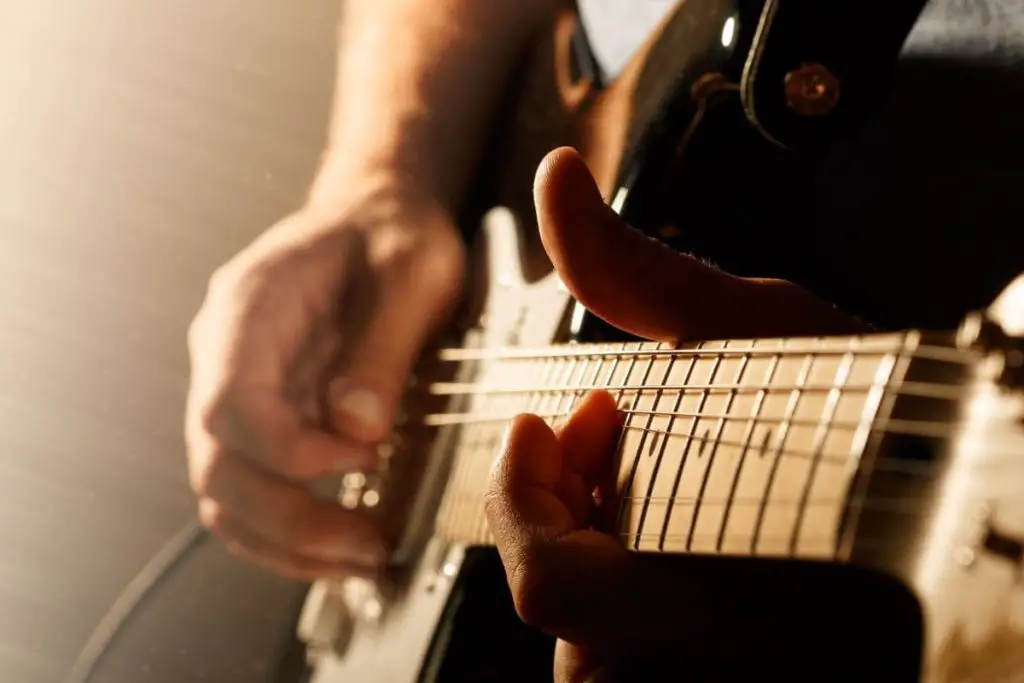
Do Not Remove the Calluses
It might be tempting to bite or cut them off when they get annoying. No matter how satisfying that might be, if you give in to the temptation, you’ll be back where you started. You’ll have to build up the callus again from scratch, and that’s a painful experience you don’t need.
Even if they get annoying, it’s best to put up with it and leave them where they are. You’ve worked hard to build them; you shouldn’t get rid of them that easily.
Getting your fingers hardened will help you bend easily and with no pain. While it might be uncomfortable at first and hurt a bit, your future self will thank you for the torture. There is no guitar technique you can learn overnight, and bending is no exception.
How To Bend Guitar Strings Without Hurting your Fingers: Final Thoughts
Here are the main steps to help you bend guitar strings without hurting your fingers:
- Set your guitar up properly.
- Use your wrist and elbow.
- Harden your fingertips.
While bending strings on a guitar can be painful at first, it’s possible to overcome the pain with some patience.
Does bending hurt your fingers guitar?
You are likely to hurt your fingers bending strings on the guitar, especially for beginners or those who have not developed the proper finger strength and calluses. It is possible to experience some discomfort or pain in the fingers when practicing bending.
However, with proper technique and consistent practice, bending strings should not cause any long-term damage to the fingers. In fact, many guitarists develop strong finger muscles and calluses that enable them to bend strings with ease and comfort.
To minimize discomfort or pain when bending strings, it is important to practice proper technique, such as using the correct finger placement, applying the right amount of pressure, and gradually building up the strength in your fingers. It is also important to take breaks and rest your fingers when they become fatigued or sore.
If you experience persistent pain or discomfort in your fingers when bending strings, it may be a sign of an underlying medical condition, such as tendinitis or carpal tunnel syndrome. In such cases, it is important to seek the advice of a medical professional.
Is it OK to bend guitar strings?
Yes, it is perfectly fine to bend guitar strings. Bending strings is a common and important technique in guitar playing, especially in blues, rock, and other styles of music that rely heavily on expressive playing. Bending strings is used to add flavor, dynamics, and emotion to a guitarist’s playing, and can be performed in a variety of ways, including quarter-tone bends, half-tone bends, and whole-tone bends.
Bending strings is a physically demanding technique that requires finger strength and dexterity, and it can take time to develop the necessary skills to execute bends effectively. With practice, however, most guitarists are able to bend strings with ease and comfort.
To minimize the risk of breaking a string or causing damage to the guitar, it is important to use the correct finger placement, apply the right amount of pressure, and gradually build up the strength in your fingers. It is also important to use the proper string gauge and to keep your guitar in good condition by regularly changing strings and performing routine maintenance.
In summary, bending guitar strings is a common and important technique that adds to a guitarist’s expressive playing. With proper technique and practice, it is perfectly fine to bend guitar strings and can greatly enhance your playing.
How do you bend guitar strings without breaking them?
Here are some tips for bending guitar strings without breaking them:
- Use the correct finger placement: To avoid putting undue stress on the strings, it is important to use the correct finger placement when bending strings. The bend should be made with the pad of the finger, rather than the tip, and the string should be held securely between the finger and the fret.
- Apply the right amount of pressure: Bending strings requires a certain amount of pressure, but too much pressure can cause the string to break. To avoid this, start with small bends and gradually work your way up to larger bends, and pay attention to how much tension you are applying to the string.
- Use the proper string gauge: The gauge of the string can also impact its ability to handle bends. Thinner strings are generally more flexible and easier to bend, while thicker strings can be more resistant to bending. Using the proper string gauge for the type of music you play can help prevent breakage.
- Keep your guitar in good condition: A poorly maintained guitar can also increase the risk of string breakage. Regularly changing strings and performing routine maintenance, such as cleaning and oiling the fretboard, can help prevent strings from breaking during bending.
By using the correct finger placement, applying the right amount of pressure, using the proper string gauge, and keeping your guitar in good condition, you can bend guitar strings without breaking them and achieve the desired expressive playing that the technique offers.
How do you bend guitar strings easily?
Here are some tips for bending guitar strings easily:
- Use the correct finger placement: To make bending easier, use the pad of your finger to press down on the string rather than the tip. This will give you more surface area to grip the string, allowing you to apply more pressure and execute the bend more easily.
- Build up finger strength: Bending strings requires finger strength, and the more you practice, the stronger your fingers will become. To build up finger strength, practice exercises that focus on bending strings, such as bending a single note or bending a group of notes up and down the fretboard.
- Gradually increase the difficulty: Start with smaller bends and work your way up to larger bends as your finger strength and technique improve. This will help you build up the necessary muscle memory and avoid injury or discomfort.
- Use the proper string gauge: Thinner strings are generally easier to bend than thicker strings, so using a lighter string gauge can make bending easier. However, it is important to use the appropriate string gauge for the type of music you play and your playing style.
- Warm up before playing: Warming up your fingers before playing can help improve your flexibility and dexterity, making bending easier. Try warming up with simple finger exercises or by playing scales or arpeggios.
By using the correct finger placement, building up finger strength, gradually increasing difficulty, using the proper string gauge, and warming up before playing, you can make bending guitar strings easier and more comfortable, allowing you to add expressiveness and dynamics to your playing.
Do professional guitarists fingers hurt?
It is not uncommon for guitarists, including professional guitarists, to experience discomfort or pain in their fingers from playing. This can be due to a variety of factors, including playing for extended periods of time, playing with excessive force or tension, or playing with poor technique.
However, most experienced guitarists have developed strong finger muscles and calluses, which allow them to play with greater ease and comfort. In fact, many guitarists see calluses as a badge of honor, as they are a sign of dedication to their craft and a testament to the amount of time they have spent practicing.
That being said, it is important for guitarists to take care of their hands and fingers, and to practice proper technique and technique exercises to minimize the risk of injury or pain. Taking breaks, stretching, and using proper posture and hand positioning can also help prevent discomfort or injury.
In summary, while it is not uncommon for guitarists, including professional guitarists, to experience discomfort or pain in their fingers from playing, most have developed the necessary finger strength and calluses to play with greater ease and comfort. It is important to practice proper technique and take care of your hands and fingers to prevent injury or pain.
How do you bend guitar strings cleanly? (Properly & Correctly)
Bending guitar strings cleanly is a skill that takes time and practice to develop. Here are some tips for achieving clean bends:
- Use the correct finger placement: To make clean bends, it is important to use the correct finger placement. The bend should be made with the pad of the finger, rather than the tip, and the string should be held securely between the finger and the fret.
- Apply even pressure: To make clean bends, it is important to apply even pressure across the entire length of the string. If you apply more pressure to one side of the string than the other, it can cause the string to slip out of your fingers or sound out of tune.
- Use your ear: To achieve clean bends, it is important to use your ear and listen to the pitch of the string as you bend it. This will help you determine if you are bending the string too far or not far enough.
- Use vibrato: Using vibrato can help hide any imperfections in your bends and make them sound smoother and more musical. To use vibrato, simply bend the string up to the desired pitch and then shake the string back and forth using your fretting hand.
- Practice: Bending guitar strings cleanly is a skill that takes time and practice to develop. Practice exercises that focus on bending strings, such as bending a single note or bending a group of notes up and down the fretboard, and gradually work your way up to more difficult bends.
By using the correct finger placement, applying even pressure, using your ear, using vibrato, and practicing regularly, you can develop the necessary skills to achieve clean bends and add expressiveness and dynamics to your playing.
How do I make my guitar strings more bendy?
If your guitar strings feel too stiff or difficult to bend, there are a few things you can try to make them more bendy:
- Use a lighter string gauge: Thinner strings are generally easier to bend than thicker strings. Consider trying a lighter string gauge, such as .009s or .010s, to make bending easier.
- Use a different type of string: Different types of strings have different levels of flexibility and bendability. Consider trying a brand or type of string that is known for its flexibility, such as nickel-plated strings.
- Stretch your strings: New strings can sometimes feel stiff or difficult to bend, so it can help to stretch them out before playing. To stretch your strings, gently pull on each string, working your way up and down the fretboard, and retune as necessary.
- Adjust your guitar’s setup: If your guitar’s action is too high, it can make bending difficult. Consider taking your guitar to a professional for a setup, which can include adjusting the action and making other adjustments to improve playability.
- Build up finger strength: Bending strings requires finger strength, so it can help to practice exercises that focus on bending strings to build up the necessary muscle memory and finger strength.
By using a lighter string gauge, using a different type of string, stretching your strings, adjusting your guitar’s setup, and building up finger strength, you can make your guitar strings more bendy and easier to play.
How to bend guitar strings without touching other strings
Here are some tips to help you achieve clean bends without touching other strings:
- Use the correct finger placement: To make clean bends without touching other strings, it is important to use the correct finger placement. The finger that is bending the string should be positioned so that it does not touch any adjacent strings.
- Mute other strings: To prevent other strings from ringing out when you bend a string, it can be helpful to use your other fingers or a fretting hand mute to mute the adjacent strings.
- Practice: Bending strings without touching other strings is a skill that takes time and practice to develop. Start with simple bends, such as bending a single note, and gradually work your way up to more complex bends and licks.
- Use vibrato: Using vibrato can help mask any imperfections in your bends and make them sound smoother and more musical. To use vibrato, simply bend the string up to the desired pitch and then shake the string back and forth using your fretting hand.
- Experiment with different techniques: There are many different techniques for bending strings, such as using your ring finger to support the finger that is bending the string, or using your thumb to support the neck of the guitar. Experiment with different techniques to find the one that works best for you.
By using the correct finger placement, muting other strings, practicing regularly, using vibrato, and experimenting with different techniques, you can learn to bend guitar strings without touching other strings and add expressiveness and dynamics to your playing.
Are thinner strings better for bending? (lighter or heavier)
Thinner guitar strings are generally better for bending than thicker strings. Thinner strings require less tension to bend, making them easier to manipulate and control. They also tend to be more flexible and have a more slinky feel, which can make it easier to bend the string to the desired pitch.
On the other hand, thicker strings require more tension to bend, which can make them more difficult to control and play. They can also put more strain on your fingers, especially if you are playing for long periods of time.
However, the choice of string gauge ultimately comes down to personal preference and playing style. Some players prefer the sound and feel of thicker strings, while others prefer the flexibility and ease of use of thinner strings. It is important to experiment with different string gauges to find the one that works best for you and your playing style.
What gauge is best for bending?
Lighter gauge strings are easier to bend than heavier gauge strings. Most electric guitar players prefer lighter gauge strings, such as .009s or .010s, which are known for their flexibility and ease of use. These strings require less tension to bend, making them easier to manipulate and control.
Acoustic guitar players may prefer slightly heavier gauge strings, such as .011s or .012s, which offer a fuller and richer tone, but are still flexible enough to allow for some bending.
Ultimately, the choice of string gauge comes down to personal preference and playing style. It is important to experiment with different string gauges to find the one that works best for you and your playing needs.
Why are electric guitar strings easier to bend?
Electric guitar strings are generally easier to bend than acoustic guitar strings due to electric guitar strings being lighter gauge than acoustic guitar strings. This means they have less mass and require less tension to bend.
Lighter gauge strings are more flexible and easier to manipulate, making it easier to achieve the desired pitch when bending a note.
Secondly, electric guitar strings are often made of materials that are more slippery than those used for acoustic guitar strings. For example, many electric guitar strings are made of nickel-plated steel, which is known for its smooth surface and low friction. This makes it easier to bend the strings without feeling like they are “sticking” to your fingers.
Finally, electric guitars typically have lower action than acoustic guitars, which means that the strings are closer to the fretboard. This makes it easier to press down on the strings and manipulate them when bending, which can make it easier to achieve the desired pitch.
Overall, the combination of lighter gauge strings, slippery materials, and lower action make electric guitar strings easier to bend than acoustic guitar strings.
If you want to find out what my recommended guitar gear is, then here is what I recommend on Amazon:
- Fender Cutaway Acoustic-Electric Guitar Bundle (MY FAVORITE GUITAR)
- Snark SN-8 Super Tight All Instrument Tuner (Easiest Tuner I’ve Used)
- 6 String Acoustic Guitar Capo (Best CAPO for quick changes)
- Dunlop Max Grip 1.0mm Nylon Picks (Thick Guitar Pick So You Don’t Lose Grip!)
- Universal Guitar Stand (Cheap & Minimalist Guitar Stand I Recommend)
- Levy’s 2″ Wide Quick Adjust Guitar Strap (Best Guitar Strap For Any Level)
Related Posts:
- 10 Best Lightest Electric Guitars that Play & Sound Great!
- How To Get Better at Lead Guitar: The Ultimate Guide
- 8 Tips for Improvising Over Guitar Jazz Chords
- Here’s Why Your Guitar Sounds Bad When in Tune
- The Complete Guide to Holding a Guitar While Standing
- How To Tell if Your Guitar Cable Is Bad
- How To Make a Pick Scratch Sound on Guitar (5 Steps)
- Guitar Keeps Going Sharp: 11 Causes and Solutions
- 9 Loudest Guitar Strings You Can Buy
- Do Acoustic Guitars Need Pickguards? The Facts Explained
- Why Do Guitars Have Soundholes? Full Explanation
- 15 Best Electric Guitar Strings
- Guitar String Tension Calculator

